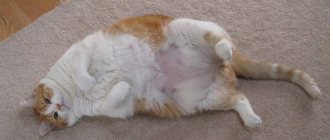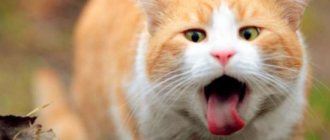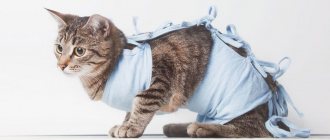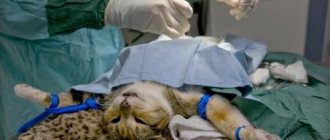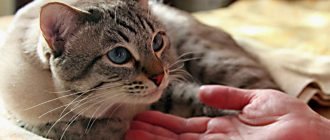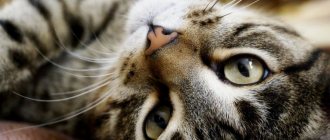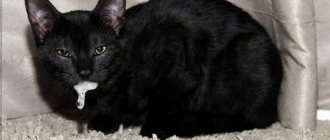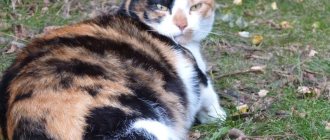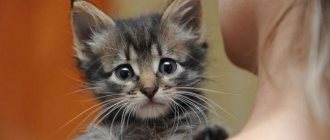18673Pavel
5
Sometimes cat owners notice that their pet begins to feel sick after eating both commercial and natural food. There are many reasons why a cat vomits after eating undigested food. And the most harmless one is overeating. Murka could simply overeat and in this way empty her stomach. Vomiting of pieces of unprocessed food can also occur if the animal has been starving for a long time. The stomach may simply not be ready to receive a significant amount of food.
But a cat’s vomiting after eating can also occur for more serious reasons. For example, a pet vomits pieces of food in the presence of chronic gastrointestinal pathology.
In any case, if a cat burps after eating for no apparent reason, then he needs a full medical examination. The veterinarian will be able to determine why the animal is vomiting after eating, and also prescribe treatment appropriate to the current condition.
© shutterstock
general information
First you need to know that vomiting in itself is not a disease. This is one of the defense mechanisms built into the mammalian body. Cats are not always able to spit out foreign objects that accidentally enter their mouth. In this case, another mechanism is triggered - the abdominal muscles and diaphragm contract, and under pressure, undigested food, along with this foreign object, comes back through the esophagus. This happens to any animal from time to time. But if vomiting occurs more often, this indicates a problem in the body.
So, vomiting is understood as a spontaneous reflex process in which the body vomits the contents of the stomach. If a cat vomits after eating, then the vomit clots contain the remains of food that have not yet been digested, as well as mucus and a certain amount of gastric juice - in general, this composition is considered normal for such a situation, even if bile is added to it, this is not always dangerous. The worst thing is if impurities of blood and pus are visible in the vomit.
Any deviations from the norm may indicate:
- severe bacterial and viral infections;
- presence of helminthiasis (parasitic infestation);
- problems with bowel function.
In this case, the cat will not only feel sick.
Intestinal diseases are also accompanied by diarrhea. And with ARVI, the temperature rises and nasal discharge may appear. Sometimes a cat can vomit quite violently due to food poisoning or chemical intoxication.
When is vomiting dangerous?
From the previous chapter, we learned that vomiting can be a symptom of many different diseases. It is impossible to say when it is more or less dangerous. If it happened only once, and the cat’s condition does not raise your suspicions, you don’t have to take any measures, but continue to observe. Repeated vomiting and visible changes in the pet's health indicate danger and require prompt diagnosis and treatment.
If vomiting is accompanied by refusal to eat, or nausea is prolonged, this may be a dangerous signal.
Main reasons
The cause of your cat's vomiting is what you need to find out before starting treatment. The main reasons include many . For example:
- Any power supply errors. It happens that a cat constantly overeats, and the body simply cannot cope with the situation otherwise. However, prolonged fasting and consumption of low-quality food leads to the same consequences. That is why the owner should not leave things to chance, but personally ensure that the pet eats on time, so that there are no long breaks between meals. Otherwise, at the first opportunity, the cat will try to make up for lost time, and from overeating he will vomit.
- Formation of a hairball in the stomach. This happens very often because cats love to lick themselves and the hairs constantly accumulate. Wool cannot be digested in the stomach, which is why it forms a lump, which prevents further passage of food through the gastrointestinal tract. If there is a kitten in the house, this happens very often, but adults also have such troubles.
- Poisoning. In this case, the body tries to get rid of toxins on its own. The main advice to the owner is to avoid dehydration and be sure to give the animal water, even by force.
- Nervous system disorders and stress. It happens that an animal begins to burp because it changes its place of residence with its owners or, conversely, ends up with new owners.
- In cats, vomiting can be a sign of pregnancy, just like in women. This happens because the growing uterus puts pressure on the gastrointestinal tract, and the animal has an unbearable desire to vomit.
You also need to remember that in cats, vomiting can be a sign of chronic liver or kidney disease, pathologies of the gastrointestinal tract, or inflammation of the pancreas. It also happens that a pet begins to regurgitate food due to the presence of worms, due to infectious diseases such as leukopenia, or due to tumors in the stomach.
The cat often burps: reasons
Regurgitation in cats is normal and occurs for the following reasons:
- Regurgitation of semi-digested food by a lactating cat occurs in order to accustom kittens to solid food.
- Toxicosis of pregnancy: occurs after two decades of gestation, when other signs have not yet appeared.
- Gluttony: wild ancestors did not have a successful hunt every day. Therefore, the animals ate for future use. But, too much food is worse than not enough. The same thing happens if the owners try to give dry food according to the norm. Or there are competitors in the apartment. The animal attacks the pellets and eats too quickly. He doesn’t have time to drink anything, dry food absorbs moisture from the gastric mucosa. The body expels dangerous food to prevent dehydration.
- Residual effects of drugs. If the animal is fed after surgery, it will vomit.
- Hungry vomiting occurs in the morning, when an animal that is accustomed to eating by the hour forgot to feed it on time. A white foamy mass appears.
- Motion sickness in transport after feeding. Pieces of food shake and irritate the walls of the stomach.
- Hairballs that a long-haired pet swallows while licking can mix with food, form trichobezoars and block the intestinal lumen. To prevent this from happening, the cat begins to cough, vomit and regurgitate dangerous lumps.
- Soured or moldy food. With improper or prolonged feeding, peroxides are formed, which the body perceives as poisons and tries to get rid of them in every possible way. An opened bag of dry food can be stored for 40 days, and a can in the refrigerator can be stored for 36 hours.
- An excess of cereals or bread with a lack of meat and vegetables is perceived by the body as spoiled food.
- Foreign object: if it comes out, vomiting stops. Otherwise, urgent veterinary attention is required.
Be sure to read:
The cat does not eat, only drinks water and vomits, what to do: symptoms and treatment, what causes it and how to help
Treatment used
Of course, the owner is interested in what to do in such cases . Otherwise, no special measures even need to be taken. For example, if a cat vomited due to toxicosis, all that remains is to wait for it to pass. If regurgitation is the result of stress, then you will also have to wait until the animal adapts to its new conditions.
It happens that a person takes in a stray animal, tries to feed it, and the cat begins to regurgitate what it has eaten. In this case, you just need to establish the right diet. You need to feed your cat more often, but in small portions, so that all the food has time to be absorbed. Gradually, portions can be increased, even every day you can slightly adjust the diet in order to gradually get closer to the norm. In addition, dry food should be selected in accordance with the age of the animal and its state of health.
By the way, special foods are produced for animals with thick hair that help remove stuck hairs from the stomach. Then the animals will not even have anything to regurgitate. Especially if they don’t need to be groomed, and the owner makes it a rule to regularly comb their fur, removing loose hairs.
If an animal walks freely on the street, then, unfortunately, it will vomit quite often, since it is very difficult to make sure that it does not eat anything prohibited, does not grab some foreign object, and does not rummage through the garbage. It is on the street that it is easiest to pick up parasites. This also needs to be monitored. Helminthiasis should be treated with special medications. But green stalks of barley and wheat, which can be grown on a windowsill, also help cleanse the body.
If the cause of vomiting could be food poisoning, you need to provide the animal with the right diet. First, you need to starve the cat for some time and only drink water. When the vomiting stops, you need to give pieces of boiled chicken in small portions every two hours. You can buy your pet meat puree, which is produced for children. You cannot immediately increase the portions; you need to wait a few days. And for another week after this, you should give only what the body can digest well, without unnecessary effort.
Some experts believe that the treatment of poisoning in a cat should be the same as in humans, and it should be given an enterosorbent, for example, Enterosgel.
A cat spits up after eating: what to do?
The cause of vomiting is the presence of food in the gastrointestinal tract. Therefore, to stop vomiting, you need to eliminate the cause - that is, food. The cat is not fed for half a day, or better yet, for a day. But you shouldn’t get carried away, because after a two-day fast, the mechanism for extracting energy from fat depots turns on. Reserve nutrients rush to the liver and a dangerous disease develops - lipidosis.
You must show your will and not react to your pet’s extortion; even a small crumb of food causes reflex vomiting. If the animal reacts to drinking, it is removed, a veterinarian is called, and before his arrival, a saline solution is injected subcutaneously in unlimited quantities.
Be sure to read:
Vomiting in a cat: causes, what different types of vomit indicate, first aid, treatment, when it is not dangerous.
The next day, the pet is given some easily digestible food in an amount of no more than 1/3 of the norm. They give him plenty of water and monitor his behavior. If no new vomiting follows, increase the portion, bringing it to normal.
During diet therapy, the use of dry granules is suspended and wet nutrition is used. It is not necessary to use Smecta or Enterosgel, however, sorbents will help normalize digestion.
Cases when to consult a doctor
In some situations, only a doctor can find a cure. Because vomiting is a sign of a more serious illness. So, you need to contact a specialist in the following cases:
- The cat vomits several times a day, and traces of blood are visible in the vomit. This may indicate gastrointestinal diseases, pancreatitis and stomach or intestinal ulcers.
- With bright yellow vomit. This may indicate that bile has accumulated in the vomit. It resembles the color of a raw egg yolk. The animal feels unwell and may refuse to eat because it feels bitter in the mouth. This indicates gallbladder disease.
- Green vomit with an unpleasant odor. This indicates the presence of a bacterial infection. Additional symptoms include diarrhea, severe fever, and decreased appetite. Often the animal behaves restlessly and tries to retire. There is no need to persuade your pet to eat; in this case, therapeutic fasting will only be useful. But the veterinarian will already prescribe the medicine; you may have to give the animal antibacterial drugs.
- Mucous vomit, in which parasites may be visible, is a sign of helminthiasis. It can also be caused by diseases of the gastrointestinal tract. In any case, it should be a reason to contact a veterinarian.
- Vomit mixed with blood indicates that there is some kind of damage in the pharynx or mouth, sometimes even mechanical. In such cases, the blood has a bright scarlet hue. If it is dark brown, then this is a sign of internal bleeding or the presence of a tumor.
- An unpleasant fecal odor from vomit may indicate that intestinal obstruction has occurred. This problem can only be solved surgically. It may also be a sign of peritonitis, and this will also require surgery.
If the cause of vomiting is a foreign body, and it does not come out with the vomit, you will also have to consult a doctor.
The periodic appearance of vomiting with white foam is, in principle, not a sign of a serious illness. But if this happens on a regular basis, then you need to consult a doctor, since we may be talking about diseases of the gastrointestinal tract.
Why does a pregnant woman vomit?
From time to time, a fatty herring fillet, mackerel, or at least sprat should appear in the bowl of a pregnant or lactating cat. If the cat vomits, the listed types of fish are replaced with others, for example, cod or trout. In addition, the future cat mother requires products to which she is instinctively drawn. This short list consists of:
- milk or, if the cat has toxicosis from milk, other products containing calcium;
- bone meal.
Breeders feed their pets 3 or 4 times a day. The volume of each serving does not exceed the dose that non-pregnant cats receive. Although the expectant mother needs to eat a lot, her small stomach cannot cope with a large amount of food, and excess food will come out in the form of vomiting.
It is not necessary to feed animals, including pregnant animals, only fresh foods. They can be replaced with dry or canned food.
A pregnant cat does not become gluttonous
If a pregnant cat vomits after eating undigested food, or if she refuses her favorite foods, the animal may feel that labor is approaching. This is not a reason to panic. You shouldn't force her to eat. All a future cat mother needs is peace and a comfortable bed. After giving birth, her appetite will return, and she will eat more than always. The size of the portions consumed by the mother in labor depends on the number of kittens.
Vomiting after eating in a cat or kitten sometimes signals the onset of an allergic reaction. If this is true, vomiting attacks will begin immediately after eating and will stop after adjusting the diet.
Important! Newborn kittens should not be overfed. Indicators of their health are their appearance and mood. Kids should look reasonably well-fed and cheerful. If the litter is large and there is not enough mother's milk, the kittens are fed with specialized food purchased at a pet store.
A cat may vomit after eating if the animal’s body is immune to certain types of food or its components. The cause of nausea may be eating food too quickly, swallowing too large pieces or large portions that the animal’s stomach is not able to handle.
Preventive actions
In most cases, all the troubles described above can be prevented . This means that you need to select high-quality food for your pet, make sure that he does not overeat, does not remain hungry, and receives all the vitamins. And, of course, preventive treatment is needed. First of all, this concerns helminthiasis. Many people believe that it is normal for a cat to have parasites. But in fact, worms significantly worsen the pet’s quality of life; they deprive it of nutrients and damage the mucous membranes of the intestines and stomach. In addition, their waste products lead to constant poisoning.
If parasites are visible in the vomit, this means that there are a lot of them inside the animal. Under no circumstances should it be brought to such a state. But then the question arises, where to put the parasites, because a cat cannot be re-educated so that it does not come into contact with the ground or with other animals. Even homebodies are given special anthelmintic drugs for prevention twice a year. And for those animals that go outside, this procedure is repeated once every three months. Your doctor will help you choose the right drug. For example, Prazitel is considered an effective remedy.
Owner reviews
The cat started vomiting after she ate. I wanted to take her to the vet, but everything turned out fine. Probably it was just a lot of food at once. Now I try not to overfeed.
Elena Novikova
One day I noticed that the cat was not having fun as usual. Found vomiting. I took him to the vet, it turned out to be food poisoning. They did not prescribe any special treatment, they did a wash and told me to watch the animal for a couple of days. Everything is fine.
Ivan Nikolaev
After the walk, I noticed that the cat began to vomit.
I immediately went with him to a specialist. In fact, the reason was banal - the animal found fur somewhere and that was why it was vomiting. Now I'm trying to take care of my pet. Marina Melnikova
